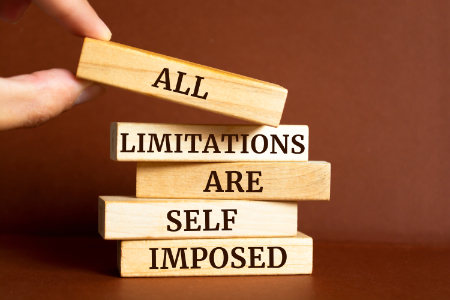
Let’s get real. You’re not stuck because of your potential. You’re stuck because of what you believe about your potential. That’s the difference between those who live big and those who play small: belief. The truth is, most people are walking around with invisible chains—subconscious thoughts and stories that tell them what they can’t do, what they don’t deserve, and what’s not possible for them. These are limiting beliefs. If you don’t recognize them and rewire them, they’ll quietly run the show, steal opportunities, and drain your energy. They are why you settle for less when you were built for more.
But here’s the good news: Every limiting belief can be broken. Let’s talk about why they show up—and how to take your power back.
Where Limiting Beliefs Come From
These beliefs don’t just appear out of nowhere. They’re learned. And if they’re learned, they can be unlearned.
1. Childhood Conditioning
You heard things like “Money doesn’t grow on trees” or “That’s just not for people like us.”
You didn’t choose those beliefs—but you absorbed them.
2. Past Failures
You tried something once and it didn’t go well. So now the mind whispers, “Don’t try that again.”
3. Fear of Rejection or Judgment
You dim your light because you’re afraid of what others might think. “If I stand out, they’ll criticize me.”
4. Fear of Success
Yes, fear of success. What if you can’t maintain it? What if people expect more from you? What if you lose it all?
5. Social Comparison
You scroll through highlight reels and convince yourself you don’t measure up.
“They’ve got something I don’t.”
6. Lack of Exposure
If you’ve never seen someone like you win, it’s easy to believe you can’t.
7. Identity Conflicts
You say you want to lead, but deep down you still see yourself as “the quiet one.” And the mind will never let you act out of alignment with your identity.
How to Break Free From Limiting Beliefs
The moment you challenge a limiting belief, it starts to lose its grip.
1. Identify the Story
Ask: What do I believe about this area of my life?
Money. Success. Relationships. Leadership.
Get honest. Write it down.
2. Ask Where It Came From
Whose voice is that?
Parents? Teachers? A boss? Society?
Most of the time, it’s not even yours.
3. Challenge the Truth
Is this belief 100% true? Has anyone like me done this before?
Look for evidence that proves the belief wrong.
4. Reframe the Thought
Turn “I always mess things up” into “Every mistake makes me wiser and better prepared.”
5. Act On the New Belief
Take action that supports your new mindset—even if it’s small.
Confidence is built through action, not affirmation alone.
6. Change Your Environment
Surround yourself with people who normalize the success you’re aiming for.
What’s common in your circle becomes possible in your mind.
The Coach Advantage: Why You Don’t Have to Do This Alone
Let’s be real—most of us are too close to our own stories to see the patterns.
That’s where a coach becomes your game-changer.
A coach helps you:
- Identify blind spots you didn’t know were there
- Reframe disempowering beliefs on the spot
- Stay accountable to the new identity you’re building
- Navigate doubt and fear without getting stuck
- Build momentum with clarity and strategy
When you’re stuck in your own head, you need a mirror. A coach reflects your potential back to you and walks beside you as you turn that potential into progress. Sometimes all it takes is one powerful question, one breakthrough conversation, one mindset shift—to blow the door wide open.
You don’t need to be “fixed” because you’re not broken. Your beliefs about yourself were never meant for you. It’s time to let those go.
You’re not here to just survive—you’re here to rise, lead, and create impact. That starts when you stop letting old beliefs dictate your future.
Want help stepping into the mindset that matches your next level? Coaching is not about changing who you are—it’s about uncovering who you’ve always been. Schedule a call here or contact us at the information below. Modern Observer Group programs are based on the Businetiks system as detailed in the book, “The Businetiks Way.”

